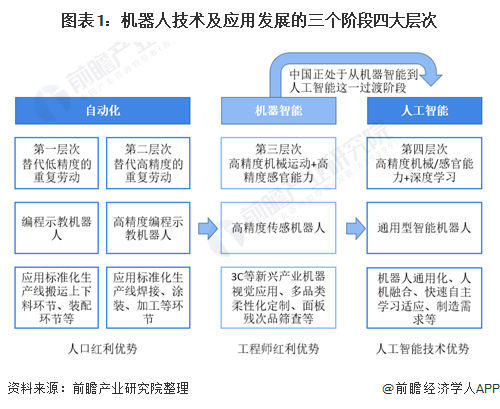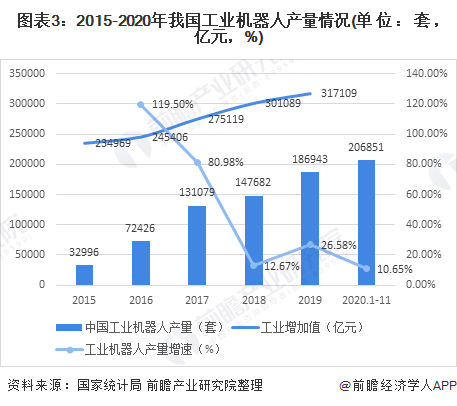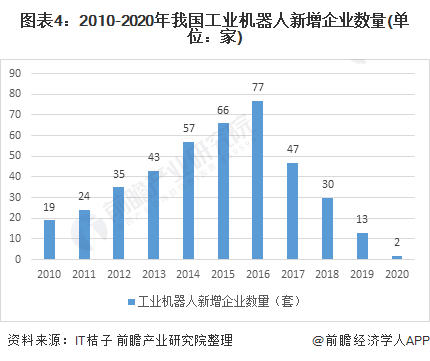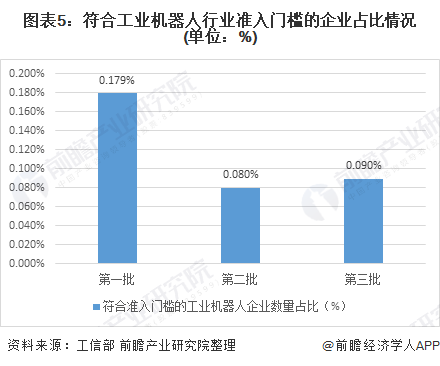Analysis of the Development Status of China’s Industrial Robotics Industry in 2021
Date:2021-02-03
Industrial Automation and "Made in China 2025" have increased the application of industrial robots in the manufacturing sector. From 2016 to 2020, the production of industrial robots in China continued to increase. In November 2020 alone, the production reached 206,851 units, although the growth rate showed some slowing down. The increasing demand in downstream application areas drove the continuous growth in the number of industrial robot enterprises. However, as the competitive landscape became apparent and the entry barriers increased, the number of new enterprises decreased, with only 2 new companies entering the industry in 2020.
Transition from Machine Intelligence to Artificial Intelligence in Industrial Robots
The development of robot technology and applications can be divided into three stages and four levels. The key factors in the development of these three stages are population dividend, engineering expertise, and artificial intelligence technology. China, with its significant population advantage, rapidly passed through the automation stage. Currently, many leading industrial robot companies in China, such as Siasun Robotics and Hikvision, have matured in machine intelligence. These companies excel in vision applications. Currently, China, like leading countries such as Japan and South Korea, is transitioning from machine intelligence to artificial intelligence. China is also at the forefront of artificial intelligence technology accumulation.
According to industry life cycle theory, the industry's life development cycle mainly includes four stages: infancy, growth, maturity, and decline. The characteristics of the industry in the mature stage are that the industry's growth rate slows to a more moderate level, the number of new enterprises decreases, entry barriers to the industry increase, and excluding the impact of technological innovation factors, the industry's development pace is synchronized with the gross domestic product.
Combining the current development of China's industrial robot industry, it can be inferred that it largely conforms to the characteristics of a mature industry. Therefore, it can be judged that the industry is currently in the transition stage from the growth period to the mature period.

The market size of industrial robots has been expanding year by year, driven by the increasing demand for industrial automation. In 2019, the market size of industrial robots in China reached 5.73 billion US dollars. While the growth rate initially increased and then decreased, it continues to show an upward trend, indicating the potential for further expansion in the future.

Industrial robot production has increased from 32,996 units in 2015 to 206,851 units by November 2020, maintaining a growth trend from 2015 to 2020. However, the growth rate has noticeably slowed during this period. The growth rate was 119.5% from 2015 to 2016, but it decreased to 12.67% the following year. The most recent growth rate is 10.65%, indicating a continued but slower expansion. This trend aligns with the pattern of industrial value-added growth over the same period.

From 2010 to 2020, the number of new industrial robot enterprises in China initially increased and then declined. The period from 2010 to 2016 witnessed growth in the number of new enterprises, followed by a consistent decrease until 2020. The decline in the number of new enterprises was more significant than the earlier increase. In 2016, the industrial robot industry saw the highest number of new enterprises, reaching 77, but by 2020, this figure had reduced to only 2.

In 2016, the Ministry of Industry and Information Technology (MIIT) established the "Industrial Robot Industry Standard Conditions," setting the entrance criteria for the industrial robot industry. Subsequently, MIIT released three batches of lists in 2018, 2019, and 2020, respectively, comprising companies meeting the composite standards. The number of compliant enterprises in each year was 15, 8, and 9, accounting for 0.179%, 0.08%, and 0.09% of the total industrial robot enterprises for the respective years. These percentages were all below 2%, indicating a very low level. Moreover, this proportion showed a declining trend, suggesting the likelihood of more regulatory documents being introduced in the future for the industrial robot industry.

Transition from Machine Intelligence to Artificial Intelligence in Industrial Robots
The development of robot technology and applications can be divided into three stages and four levels. The key factors in the development of these three stages are population dividend, engineering expertise, and artificial intelligence technology. China, with its significant population advantage, rapidly passed through the automation stage. Currently, many leading industrial robot companies in China, such as Siasun Robotics and Hikvision, have matured in machine intelligence. These companies excel in vision applications. Currently, China, like leading countries such as Japan and South Korea, is transitioning from machine intelligence to artificial intelligence. China is also at the forefront of artificial intelligence technology accumulation.
According to industry life cycle theory, the industry's life development cycle mainly includes four stages: infancy, growth, maturity, and decline. The characteristics of the industry in the mature stage are that the industry's growth rate slows to a more moderate level, the number of new enterprises decreases, entry barriers to the industry increase, and excluding the impact of technological innovation factors, the industry's development pace is synchronized with the gross domestic product.
Combining the current development of China's industrial robot industry, it can be inferred that it largely conforms to the characteristics of a mature industry. Therefore, it can be judged that the industry is currently in the transition stage from the growth period to the mature period.

The market size of industrial robots has been expanding year by year, driven by the increasing demand for industrial automation. In 2019, the market size of industrial robots in China reached 5.73 billion US dollars. While the growth rate initially increased and then decreased, it continues to show an upward trend, indicating the potential for further expansion in the future.

Industrial robot production has increased from 32,996 units in 2015 to 206,851 units by November 2020, maintaining a growth trend from 2015 to 2020. However, the growth rate has noticeably slowed during this period. The growth rate was 119.5% from 2015 to 2016, but it decreased to 12.67% the following year. The most recent growth rate is 10.65%, indicating a continued but slower expansion. This trend aligns with the pattern of industrial value-added growth over the same period.

From 2010 to 2020, the number of new industrial robot enterprises in China initially increased and then declined. The period from 2010 to 2016 witnessed growth in the number of new enterprises, followed by a consistent decrease until 2020. The decline in the number of new enterprises was more significant than the earlier increase. In 2016, the industrial robot industry saw the highest number of new enterprises, reaching 77, but by 2020, this figure had reduced to only 2.

In 2016, the Ministry of Industry and Information Technology (MIIT) established the "Industrial Robot Industry Standard Conditions," setting the entrance criteria for the industrial robot industry. Subsequently, MIIT released three batches of lists in 2018, 2019, and 2020, respectively, comprising companies meeting the composite standards. The number of compliant enterprises in each year was 15, 8, and 9, accounting for 0.179%, 0.08%, and 0.09% of the total industrial robot enterprises for the respective years. These percentages were all below 2%, indicating a very low level. Moreover, this proportion showed a declining trend, suggesting the likelihood of more regulatory documents being introduced in the future for the industrial robot industry.

Previous Article: What is the difference between domestic co-robots and imported co-robots?
Next Article: The benefits of co-robots to manufacturing